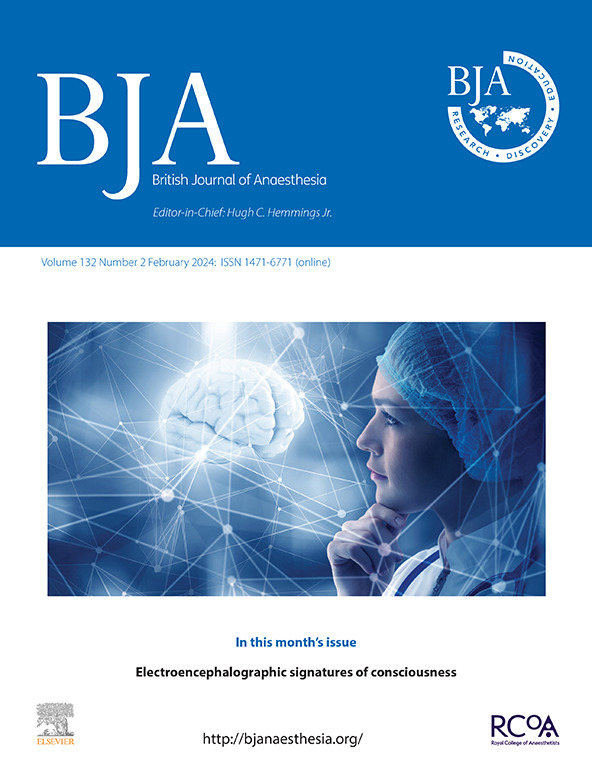Association between plasma growth differentiation factor-15 and postoperative nausea and vomiting incidence and severity: a secondary analysis of a randomised trial
IF 9.2
1区 医学
Q1 ANESTHESIOLOGY
引用次数: 0
Abstract
Background
Postoperative nausea and vomiting (PONV) distresses patients and hinders recovery. Identifying biomarkers can optimise prophylactic strategies. This study investigated whether plasma growth differentiation factor-15 (GDF-15) concentrations were associated with PONV in at-risk adult patients undergoing laparoscopic gastrointestinal surgery.
Methods
Patients (n = 896) from a previous randomised controlled trial were included. Blood samples were collected before surgery in the pre-anaesthesia room and at the end of surgery. Plasma GDF-15 concentrations were measured using the Human GDF-15 ELISA Kit. The primary outcome was PONV, defined as nausea, retching, or vomiting, within 120 h after surgery.
Results
A total of 860 (96.0%) of patients were female. During 0–120 h after surgery, 531 (59.3%) patients experienced PONV. Unadjusted logistic models showed negative associations between preoperative and postoperative GDF-15 concentrations and PONV, but this association was not significant for postoperative concentrations after adjustment for confounders including preoperative concentrations. Compared with the first tertile of preoperative GDF-15 concentrations, the second tertile had an adjusted odds ratio (aOR) of 0.63 (95% confidence interval [CI] 0.44–0.91; P=0.013), and the third tertile had an aOR of 0.44 (95% CI 0.30–0.64; P<0.001) for PONV. Restricted cubic splines showed that PONV odds decreased rapidly until the preoperative GDF-15 concentrations were 830.36 pg ml−1 and then plateaued (P for overall <0.001, P for non-linearity=0.002). Compared with a low-maintaining trajectory, a high-increasing trajectory had an aOR of 0.64 (95% CI 0.46–0.89; P=0.008) for PONV.
Conclusions
Lower preoperative plasma GDF-15 concentrations or low-maintaining trajectory were associated with higher odds of PONV in laparoscopic gastrointestinal surgery patients.
血浆生长分化因子-15与术后恶心呕吐发生率和严重程度的关系:一项随机试验的二次分析
背景:术后恶心和呕吐(PONV)困扰患者并阻碍康复。识别生物标志物可以优化预防策略。本研究调查了接受腹腔镜胃肠手术的高危成人患者血浆生长分化因子-15 (GDF-15)浓度是否与PONV相关。方法:纳入先前随机对照试验的患者(n = 896)。术前在麻醉前室和手术结束时采集血样。使用Human GDF-15 ELISA Kit测定血浆GDF-15浓度。主要终点为PONV,定义为术后120小时内恶心、干呕或呕吐。结果:女性860例,占96.0%。术后0 ~ 120 h, 531例(59.3%)患者出现PONV。未经调整的logistic模型显示术前和术后GDF-15浓度与PONV之间存在负相关,但在调整混杂因素(包括术前浓度)后,术后浓度与PONV之间的相关性不显著。与术前GDF-15浓度的第一分位数相比,第二分位数的校正优势比(aOR)为0.63(95%可信区间[CI] 0.44-0.91;P=0.013),第三个五分位数的aOR为0.44 (95% CI 0.30-0.64;结论:术前较低的血浆GDF-15浓度或低维持轨迹与腹腔镜胃肠道手术患者PONV的高发生率相关。
本文章由计算机程序翻译,如有差异,请以英文原文为准。
求助全文
约1分钟内获得全文
求助全文
来源期刊
CiteScore
13.50
自引率
7.10%
发文量
488
审稿时长
27 days
期刊介绍:
The British Journal of Anaesthesia (BJA) is a prestigious publication that covers a wide range of topics in anaesthesia, critical care medicine, pain medicine, and perioperative medicine. It aims to disseminate high-impact original research, spanning fundamental, translational, and clinical sciences, as well as clinical practice, technology, education, and training. Additionally, the journal features review articles, notable case reports, correspondence, and special articles that appeal to a broader audience.
The BJA is proudly associated with The Royal College of Anaesthetists, The College of Anaesthesiologists of Ireland, and The Hong Kong College of Anaesthesiologists. This partnership provides members of these esteemed institutions with access to not only the BJA but also its sister publication, BJA Education. It is essential to note that both journals maintain their editorial independence.
Overall, the BJA offers a diverse and comprehensive platform for anaesthetists, critical care physicians, pain specialists, and perioperative medicine practitioners to contribute and stay updated with the latest advancements in their respective fields.

 求助内容:
求助内容: 应助结果提醒方式:
应助结果提醒方式:


